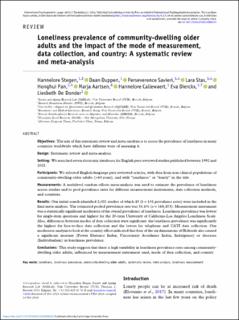| dc.contributor.author | Stegen, Hannelore | |
| dc.contributor.author | Duppen, Daan | |
| dc.contributor.author | Savieri, Perseverence | |
| dc.contributor.author | Stas, Lara | |
| dc.contributor.author | Pan, Honghui | |
| dc.contributor.author | Aartsen, Marja | |
| dc.contributor.author | Callewaert, Hannelore | |
| dc.contributor.author | Dierckx, Eva | |
| dc.contributor.author | De Donder, Liesbeth | |
| dc.date.accessioned | 2024-04-02T07:55:56Z | |
| dc.date.available | 2024-04-02T07:55:56Z | |
| dc.date.created | 2024-03-28T13:34:52Z | |
| dc.date.issued | 2024 | |
| dc.identifier.issn | 1041-6102 | |
| dc.identifier.uri | https://hdl.handle.net/11250/3124385 | |
| dc.description.abstract | Objectives: The aim of this systematic review and meta-analysis is to assess the prevalence of loneliness in many
countries worldwide which have different ways of assessing it.
Design: Systematic review and meta-analysis.
Setting: We searched seven electronic databases for English peer-reviewed studies published between 1992 and
2021.
Participants: We selected English-language peer-reviewed articles, with data from non-clinical populations of
community-dwelling older adults (>60 years), and with “loneliness” or “lonely” in the title.
Measurements: A multilevel random-effects meta-analysis was used to estimate the prevalence of loneliness
across studies and to pool prevalence rates for different measurement instruments, data collection methods,
and countries.
Results: Our initial search identified 2,021 studies of which 45 (k = 101 prevalence rates) were included in the
final meta-analysis. The estimated pooled prevalence rate was 31.6% (n = 168,473). Measurement instrument
was a statistically significant moderator of the overall prevalence of loneliness. Loneliness prevalence was lowest
for single-item questions and highest for the 20-item University of California-Los Angeles Loneliness Scale.
Also, differences between modes of data collection were significant: the loneliness prevalence was significantly
the highest for face-to-face data collection and the lowest for telephone and CATI data collection. Our
moderator analysis to look at the country effect indicated that four of the six dimensions of Hofstede also caused
a significant increase (Power Distance Index, Uncertainty Avoidance Index, Indulgence) or decrease
(Individualism) in loneliness prevalence.
Conclusions: This study suggests that there is high variability in loneliness prevalence rates among community-
dwelling older adults, influenced by measurement instrument used, mode of data collection, and country. | en_US |
| dc.language.iso | eng | en_US |
| dc.rights | Navngivelse 4.0 Internasjonal | * |
| dc.rights.uri | http://creativecommons.org/licenses/by/4.0/deed.no | * |
| dc.title | Loneliness prevalence of community-dwelling older adults and the impact of the mode of measurement, data collection, and country: A systematic review and meta-analysis | en_US |
| dc.type | Peer reviewed | en_US |
| dc.type | Journal article | en_US |
| dc.description.version | publishedVersion | en_US |
| cristin.ispublished | true | |
| cristin.fulltext | original | |
| cristin.qualitycode | 1 | |
| dc.identifier.doi | 10.1017/S1041610224000425 | |
| dc.identifier.cristin | 2257575 | |
| dc.source.journal | International Psychogeriatrics | en_US |

